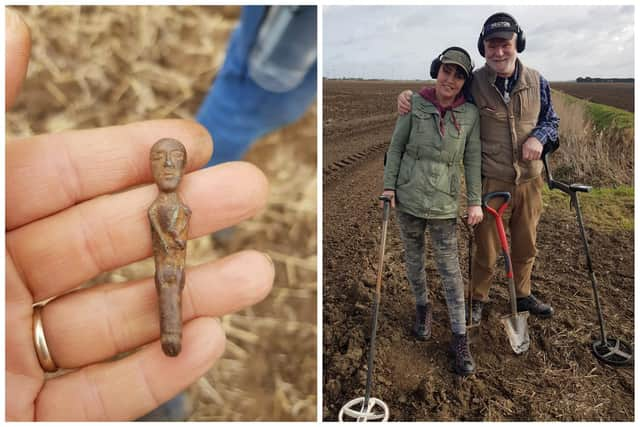Ancient Celtic fertility figure found by Cambridgeshire metal detectorist sells for double expected price at auction
and live on Freeview channel 276
An ancient Celtic fertility figure with ‘an oversized phallus’ has been sold at auction for double it’s expected price.
The small, 2,000 year old bronze figure was found by March metal detectorist Paul Shepheard had been expected to sell for between £800 and £1,200 – but when it went under the hammer on Thursday, March 9, it eventually sold for £2,200.
Advertisement
Hide AdAdvertisement
Hide AdThe statue was described by auctioneers Noonans as ‘a bronze nude figure holding in his right hand an oversized phallus which is hinged for movement’ and 5.5cm high by 1.2cm wide.


Paul (69), watched the auction from home. He has been detecting for 25 years and said: “We are really pleased with the price that the figure made. We really enjoy metal detecting and go out at least three times a week – nothing would stop us doing that! However, finding Items like ours is a rare event and it was great to see how it sold and the interest is received.
“We plan to use the proceeds from the sale to pay for a holiday to Kos for my wife and her mother.”
Nigel Mills, Consultant at Noonans said: “Dating to the Celtic period from the 1st century AD, this is a representation of a fertility god, probably based on the Roman god Mercury as he is holding a purse in his left hand.
Advertisement
Hide AdAdvertisement
Hide Ad“This male figure with its hinged oversized phallus would have had symbolic powers of good luck and warding off evil spirits and may have served as a locking mechanism as a buckle to hold a belt and scabbard for a sword.”
The item was discovered in Lincolnshire in 2022 by Paul who was searching a field with wife Joanne. She had just found a Medieval penny and he was hoping his luck would change. He uncovered what he thought was a steel split pin commonly used to retain wheels on farm carts – but after looking more closely, he saw the outline of a face and realised it was more significant.